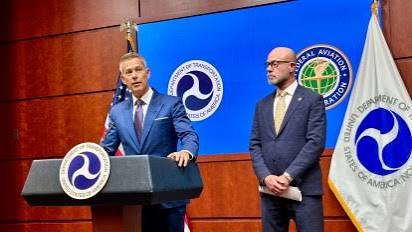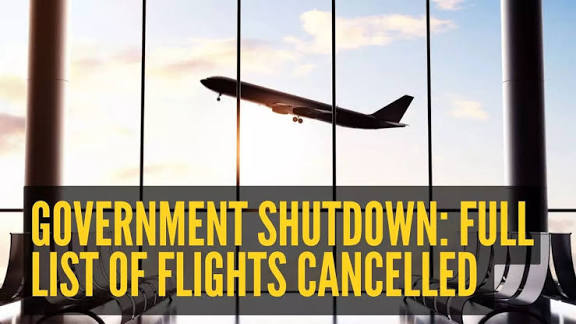Government shutdown faa airports: Flight cancellations,40 airports affected,vote results today

DOT today announced that air traffic at 40 busy airports will be reduced by 10%, potentially affecting thousands of flights. Today we will discuss about Government shutdown faa airports: Flight cancellations,40 airports affected,vote results today
Government shutdown faa airports: Flight cancellations,40 airports affected,vote results today
As the U.S. federal government shutdown enters its longest stretch in history, the ripple effects are being felt — acutely — in the nation’s aviation system. The Federal Aviation Administration (FAA) has announced that if the impasse continues, it will require airlines to reduce flight capacity by 10 percent at 40 major airports across the country.
This unprecedented move comes in response to severe staffing shortages among air‑traffic controllers and other essential aviation personnel, who have been working without pay amid the shutdown.
Below is a detailed look at how we arrived at this moment, what it means for travellers, for airlines, for air traffic control safety, and for the politics behind the shutdown.
1. Background: How the shutdown escalated for aviation

The federal government shutdown began on October 1, 2025, when Congress failed to pass the appropriations bills needed to keep many agencies funded. As a result, many federal employees designated as “essential” continue to work — but without pay — while others are furloughed.
Among the hardest hit has been the aviation sector: the FAA reports that roughly 13,000 air‑traffic controllers and 50,000 Transportation Security Administration (TSA) agents are working without pay amid the shutdown.
Even before the 10 percent cut mandate, signs of stress were mounting:
-
At several major airports, staffing‑trigger advisories were issued by the FAA due to increases in controller absences.
-
In one extreme case, Hollywood Burbank Airport (in California) was unmanned for more than five hours due to no controllers on duty, leading to severe delays.
-
Delays ballooned: At airports including Chicago O’Hare International Airport, average delays of 41 minutes were recorded when staffing issues hit.
In short, the shutdown exacerbated an existing vulnerability in the aviation system: unaided reliance on essential workers who were now working without compensation and increasingly absent or fatigued.
2. The FAA’s 10 Percent Reduction: What’s changing
On November 5, 2025, U.S. Transportation Secretary Sean Duffy and FAA Administrator Bryan Bedford announced that if the shutdown continues, the agency will require airlines to reduce flight operations by 10 percent at 40 major “high‑volume” airports starting Friday.
Some key details:
-
The reduction applies at 40 airports, though the full list has not been publicly confirmed.
-
The reductions will affect commercial passenger flights, cargo flights, and private aircraft operations in those airports.
-
The reduction is phased: initial cuts start around 4 percent on Friday, rising to 10 percent by next week.
-
The reductions could translate into ~1,800 flights cancelled or removed from schedule and over 268,000 airline seats eliminated at those hubs.
In short: The FAA is shifting from reactive “delay” mode to a proactive operation reduction mode, explicitly in response to what it deems an unsustainable staffing situation.
3. Airports and Flights Affected: Where and how badly
3.1 Which airports are likely included?
While the FAA has not disclosed the full list of 40 airports, reporting suggests that many of the major U.S. hubs will be included:
-
Airports in New York City (John F. Kennedy International Airport, LaGuardia Airport, Newark Liberty International Airport) are cited.
-
Other likely airports: Hartsfield‑Jackson Atlanta International Airport, Los Angeles International Airport (LAX), Chicago O’Hare International Airport (ORD), Dallas/Fort‑Worth, Denver, etc.
-
One list compiled by users includes Anchorage, Atlanta, Boston, Baltimore/Washington, Charlotte, Cincinnati/Northern Kentucky, Dallas Love Field, Reagan National, Denver, Detroit, Newark, Honolulu, Houston Hobby, Washington Dulles, Indianapolis, Las Vegas, Orlando, Miami, Minneapolis, Oakland, Portland, San Diego, San Francisco, Salt Lake City, Tampa, etc.
3.2 What’s the scale of the impact?
-
Prior to the cut‑mandate, over 3,000 flights were already being delayed in a single day due to staffing shortages and the shutdown. For example, at Chicago O’Hare alone more than 570 flights were delayed one day.
-
Just over a weekend (Friday‑Sunday), more than 16,700 flights were delayed and 2,282 cancelled across the U.S. in major hubs.
-
The 10 percent cut at 40 airports could impact up to ~1,800 flights daily by one estimate.
3.3 What exactly travellers will face
For travellers this means:
-
Increased cancellations: Some flights already scheduled may be removed or not taken off.
-
Longer delays: With fewer slots available, even “running” flights may face longer holds or reroutes.
-
Flight schedules may change at short notice: airlines must coordinate with FAA and adjust.
-
Cargo and private aviation also affected: It’s not just commercial passenger flights.
-
Certain parts of airspace may be closed if controller staffing falls further. Secretary Duffy warned of “mass chaos” and air‑space closure if the shutdown continues.
4. Why this decision now? Underlying causes and safety concerns
4.1 Staffing shortages & fatigue
As the shutdown continues, the burden on air traffic controllers has grown: they are working without pay, many are calling in sick or leaving, and fatigue and stress are rising.
In New York area airports, controller absence rates hit ~80 percent at some facilities.
The FAA has planted “staffing triggers” when certain centers or towers drop below safe operational levels; such triggers have been activated repeatedly in recent weeks.
4.2 Pre‑emptive safety measure
The FAA emphasises that the flight reductions are not punitive or political but safety‑driven. The agency’s “sole role is to make sure we keep this airspace as safe as possible.”
By reducing volume at certain hubs, the agency aims to lower stress on controllers, reduce complexity of operations, and maintain safe separation and sequencing of flights even under constrained staffing.
4.3 Political leverage & financial strain
While the FAA and DOT insist this is about safety, the backdrop is undeniably political. The shutdown has left many essential government workers unpaid, which increases risk of absenteeism. Some analysts suggest the move could serve as indirect pressure on lawmakers to end the shutdown.
Further, some programs such as the Essential Air Service (which subsidises flights to rural airports) face funding jeopardy, meaning effects may spread beyond major hubs.
5. Traveller and airline responses
5.1 Traveller advice
-
Check with your airline: Prior to the flight, check status for cancellations or rescheduling, especially if flying into or out of a major U.S. hub.
-
Allow extra time: Expect delays in departures, arrivals, or at security lines (TSA workers also unpaid).
-
Consider alternate airports: If your itinerary is flexible, look at less‑affected smaller airports or later flights.
-
Be ready for change: Airlines may adjust schedules rapidly based on FAA directives; some flights may be removed at short notice.
-
Stay updated: Subscribe to airline alerts, monitor flight‑tracking apps, and check whether your airport is among those facing reductions.
5.2 Airline operations & cost implications
-
Airlines must adjust scheduling, load‑factor planning, and slot allocations in affected hubs.
-
Cancellations and delays raise costs: repositioning aircraft, crew logistics, passenger compensation or accommodation, customer relations.
-
Cargo operations may suffer: reduced flights mean fewer cargo slots, affecting shipping timelines and costs.
-
Airlines for America, the trade group representing major carriers, issued a statement indicating that carriers are working with the federal government to understand all details of the new reduction mandate and will strive to mitigate impacts to passengers and shippers.
6. Wider Implications: Aviation industry & economy
6.1 Economic ripple‑effects
Major airports are economic engines: flight cancellations and capacity cuts can affect tourism, business travel, freight shipping, logistics chains, and airport concession revenues.
Smaller regional airports may also feel the squeeze if larger hubs shift capacity or reroute connections.
6.2 Safety & system resilience
The situation highlights the fragility of the U.S. national airspace system (NAS) under staffing pressure. The fact that an airport tower can be unmanned for hours (as happened at Burbank) points to systemic risk if the shutdown persists.
This brings into question whether further “air‑space closures” or more sweeping capacity reductions are next, as the FAA has warned.
6.3 Political & regulatory fallout
The shutdown and its aviation impacts may influence public opinion on government funding, essential worker pay, and air‑traffic‑controller staffing policy.
Regulators may face pressure post‑crisis to address controller shortages, revise staffing rules, or restructure how essential services are funded during budget impasses.
7. What’s next: Outlook & key variables
7.1 When might normal operations resume?
The primary variable: when Congress passes funding to reopen the affected agencies (FAA, TSA etc). Until then, the staffing strain persists and the FAA retains the authority to reduce capacity further.
7.2 Could reductions deepen?
Yes. If staffing issues worsen — for example, if absence rates climb further, or major controllers resign — the FAA may reduce capacity beyond 10 percent, or impose further restrictions on air‑space usage. Secretary Duffy’s warning of possible air‑space closure underscores this risk.
7.3
How useful was this post?
Click on a star to rate it!
Average rating 0 / 5. Vote count: 0
No votes so far! Be the first to rate this post.
About the Author
usa5911.com
Administrator
Hi, I’m Gurdeep Singh, a professional content writer from India with over 3 years of experience in the field. I specialize in covering U.S. politics, delivering timely and engaging content tailored specifically for an American audience. Along with my dedicated team, we track and report on all the latest political trends, news, and in-depth analysis shaping the United States today. Our goal is to provide clear, factual, and compelling content that keeps readers informed and engaged with the ever-changing political landscape.




